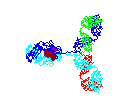Search Cidpusa web
IVIG Protocol
😏cidpusa.orgIgG Subclasses,
Clinical Implications of Human Immunoglobulin ClassesAdapted from:F.T. Fischbach in "A Manual of Laboratory Diagnostic Tests,"
2nd Ed., J.B. Lippincott Co., Philadelphia, PA, 1984.
 Rotating antibody
IgG
Rotating antibody
IgG
1. Increases in:
a) Chronic granulomatous infections
b) Infections of all types
c) Hyperimmunization
d) Liver disease
e) Malnutrition (severe)
f) Dysproteinemia
g) Disease associated with hypersensitivity granulomas, dermatologic disorders, and IgG myeloma
h) Rheumatoid arthritis
2. Decreases in:
a) Agammaglobulinemia
b) Lymphoid aplasia
c) Selective IgG, IgA deficiency
d) IgA myeloma
e) Bence Jones proteinemia
f) Chronic lymphoblastic leukemia
IgM
1. Increases (in adults) in:
a) Waldenstrom's macroglobulinemia
b) Trypanosomiasis
c) Actinomycosis
d) Carrion's disease (bartonellosis)
e) Malaria
f) Infectious mononucleosis
g) Lupus erythematosus
h) Rheumatoid arthritis
I) Dysgammaglobulinemia (certain cases)
Note: In the newborn, a level of IgM above 20 ng./dl is an indication of in utero stimulation of the immune system and stimulation by the rubella virus, the cytomegalovirus, syphilis, or toxoplasmosis.
2. Decreases in:
a) Agammaglobulinemia
b) Lymphoproliferative disorders (certain cases)
c) Lymphoid aplasia
d) IgG and IgA myeloma
e) Dysgammaglobulinemia
f) Chronic lymphoblastic leukemia
IgA
1. Increases in:
a) Wiskott-Aldrich syndrome
b) Cirrhosis of the liver (most cases)
c) Certain stages of collagen and other autoimmune disorders such as rheumatoid arthritis and lupus erythematosus
d) Chronic infections not based on immunologic deficiencies
e) IgA myeloma
2. Decreases in:
a) Hereditary ataxia telangiectasia
b) Immunologic deficiency states (e.g., dysgammaglobulinemia, congenital and acquired agammaglobulinemia, and hypogammaglobulinemia)
c) Malabsorption syndromes
d) Lymphoid aplasia
e) IgG myeloma
f) Acute lymphoblastic leukemia
g) Chronic lymphoblastic leukemia
IgD
1. Increases in:
a) Chronic infections
b) IgD myelomas
IgE
1. Increases in:
a) Atopic skin diseases such as eczema
b) Hay fever
c) Asthma
d) Anaphylactic shock
e) IgE-myeloma
2. Decreases in:
a) Congenital agammaglobulinemia
b) Hypogammaglobulinemia due to faulty metabolism or synthesis of immunoglobulins
😏